- Home
- About
- News
- Buy Tests / Products
- Parasite Cleanse
- Parasites
- FAQs
- Sample Test Reports
- Test Instructions & Requisition Forms
- Parasite Wiki
- Services / Consultations
- Testimonials
- Publications & Videos
- Lectures & Seminars
- Contact Us
Visit our Shop
Click here to see our Products

Parasites
Introduction
Many of us have heard about parasites in humans such as giardia or amoebas, but we tend to overlook the relationship between these parasites and digestive and systemic diseases and disorders. The common belief that people in developed countries are free of parasites is a great illusion. Some estimate that about 50 million American children are infected with worm parasites; only a small portion of which is detected and reported. This is particularly worrisome when one recognizes that microscopic (single-celled protozoans ), make up about 90% of all parasitic infections in the US according to the Centers for Disease Control and Prevention. If existing parasitic infections are evenly distributed, there would be more than enough parasites for every living person to have one. The most recent statistics of the worldwide prevalence of certain selected parasites follows:
| Disease | Human infections | Annual deaths |
|---|---|---|
|
Malaria |
489 million |
1-2 million |
|
All worms |
4.5 billion |
|
|
Ascaris |
1.0 billion |
20 thousands |
|
Hookworms |
900 million |
50-60 thousands |
|
Whipworms |
750 million |
|
|
Filarial worms |
657 million |
20-50 thousands |
|
Schistosomes |
200 million |
0.5-1.0 million |
This is only some of the examples of parasitism compromising human health worldwide. In temperate areas we are uneducated about the seriousness of parasitic diseases that reach their greatest impact in "tropical" countries from which many immigrate to the US & Europe. Contributing factors to parasitic diseases in developed countries, other than our own endemic parasites and immigration, include malnutrition, population density, economic conditions, sanitary practices, and life styles. Compounding factors include the lack of public/media awareness, educational materials/counseling and training of the public, as well as in some cases, the professional community.
How we contract parasites
A parasite is a micro- or macro-organism that needs to satisfy its vital nutritional requirements by feeding off certain host tissues or body fluids that contain the specific biochemicals that it needs. There are parasites for every single tissue of the human body, once they gain access. An intestinal parasite has to gain access via the oral cavity with contaminated food or drink if it is to cause infection. Other portals of entry are irrelevant. Eight ways by which humans can contract parasitic infections are briefly summarized below.
Drinking Water: Some of the most common microscopic human parasites (Protozoa) are transmitted via drinking water contaminated with fecal material from infected persons. This simple cycle occurs in water from running streams as well as from tap water in homes in large cities served by surface water treatment plants. Parasites transmitted in this manner include Cryptosporidium and Giardia .
Skin contact with contaminated water : This is the only method of infection available to certain parasites such as the schistosomes, some of the deadliest fluke (trematode) parasites of mankind. After emerging from the snail host, the infective larvae (cercariae) penetrate the skin of a person (swimmer, agricultural worker, children playing, etc.) and migrate in the human body ending up as adults in blood vessels (hepatic portal system). To get infected, one has to be exposed in an endemic area, ex., Africa, China, Mexico, Puerto Rico. The PCI lab have identified eggs in fecal samples from an isolated area near a stream in California nearby where a population of Vietnamese immigrants have settled.
Food : Food intake is perhaps one of the most common ways of transmission of parasitic infections caused by microscopic (Protozoa) and macroscopic (worm, helminth) parasites alike. For example, Blastocystis and the cysts of the amoebas (both are protozoans) are infective when swallowed with contaminated food via the fecal-oral route. This can occur in a household setting or a restaurant. Similarly, the ingestion of the eggs of the human roundworm, Ascaris, readily occurs when fresh vegetables, ex., lettuce, grown in farms fertilized with infected human waste, are eaten without proper washing.
Insects : Most blood sucking insects are capable of transmitting infectious agents via their bite as they attempt to feed on human blood. In the US, ticks transmit lyme disease, Rocky Mountain spotted fever, relapsing fever, Colorado tick fever, babesiosis, and rabbit fever; fleas transmit plague and endemic typhus, mosquitoes transmit malaria and dog heartworm, Triatoma (kissing) bugs transmit Chagas disease, and head lice can transmit epidemic typhus. If a person has had a history of a recent insect bite in any temperate or tropical part of the world, his/her blood should be tested for parasites. Insect-borne pathogens normally cause no harm to their natural (reservoir) hosts, ex., rodents, but become highly pathogenic in humans (their unnatural hosts).
Air : Air-borne viruses, bacteria, and fungi are usually eliminated with the feces (occasionally orally) of a natural reservoir (usually wildlife) host but infect humans upon accidental inhalation. Examples in North America include histoplasmosis, Valley fever, and Hanta virus. These diseases are associated with bat guano, dust, and rodent feces, respectively.
Pets : Despite what you may have been told, dogs, among other pets, are not man's best friend, parasitologically speaking. Dogs carry an intestinal tapeworm, Echinococcus, whose eggs spread all over their fur from the anal orifice during grooming. Unhealthy human contact with infected dogs, e.g., by kissing, brings the eggs into the human intestine which they penetrate as larvae and encyst in the body cavity, e.g., the liver or even the brain, as the life threatening hydatid cysts. Other worm parasites (helminths) are also readily transmitted from pets and other animals to man. Most notable are the beef and swine tapeworms , Taenia, by the consumption of beef and ham contaminated with larvae of these tapeworms.
People : Close human-to-human contact is conducive to transmission of quite an assortment of sexually transmitted diseases including AIDS and herpes as well as other viruses causing cold and flu. Eating food in a restaurant or at home that may have been contaminated with Taenia eggs or Entamoeba cysts from the servers fecal through improper sanitary practices will surely produce infections with cysticercosis (appearing as lumps in the body or nerve organs) or amoebiasis (causing severe gastrointestinal distress, etc.), respectively. A recent inspection of an expensive restaurant in Los Angeles showed that 100% of all employees (not just servers) had fecal matter under their nails.
Soil : Certain roundworm (nematode) parasites spend their transitional stages between one host and another as immature larvae in warm moist soil. Walking bare-footed or sitting on such fecally contaminated "seeded" soil in a wooded area or by a lake side, etc. will invite the larvae of hookworms or Strongyloides to penetrate the exposed skin and migrate in the body to finally become adults in the intestinal tract where the damage is done.
Pictures of Parasites
.jpg) Ancylostoma duodendal (human hookworm)
Ancylostoma duodendal (human hookworm)
Adults of hookworm infections will lay eggs like the one above in the intestinal tract of patients where they suck their blood intensively to the point of serious anemia and weakness.
 egg.jpg) Ascaris (human roundworm)
Ascaris (human roundworm)
The larvae of the human roundworm is emerging from an egg infecting salad vegetables that become the source of human infections. Such eggs are common in farms fertilized by infected human waste.
 fertile egg.jpg) Ascaris lumbricoides (roundworm) egg
Ascaris lumbricoides (roundworm) egg
This is one of few thousand eggs layed or produced by one female human roundworm. The eggs are the transmission stage between one host and another. Adults feed intensively in the intestines of humans and may pentrate the gut wall causing peritonitis and introducing secondary bacterial infections.
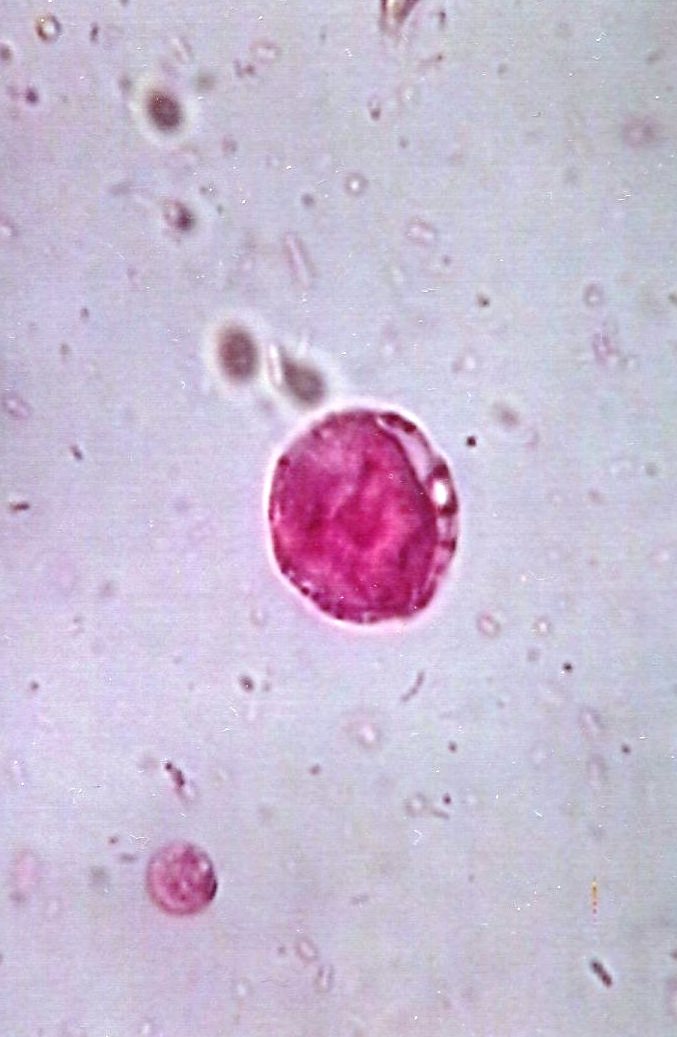 Blastocystis hominis
Blastocystis hominis
The most common protozoan parasite in the United States. It constitutes about 60% of all human parasites in N. America and can inflict considerable pathology in the intestinal tract iof infected patients. See relevant publications by Amin.
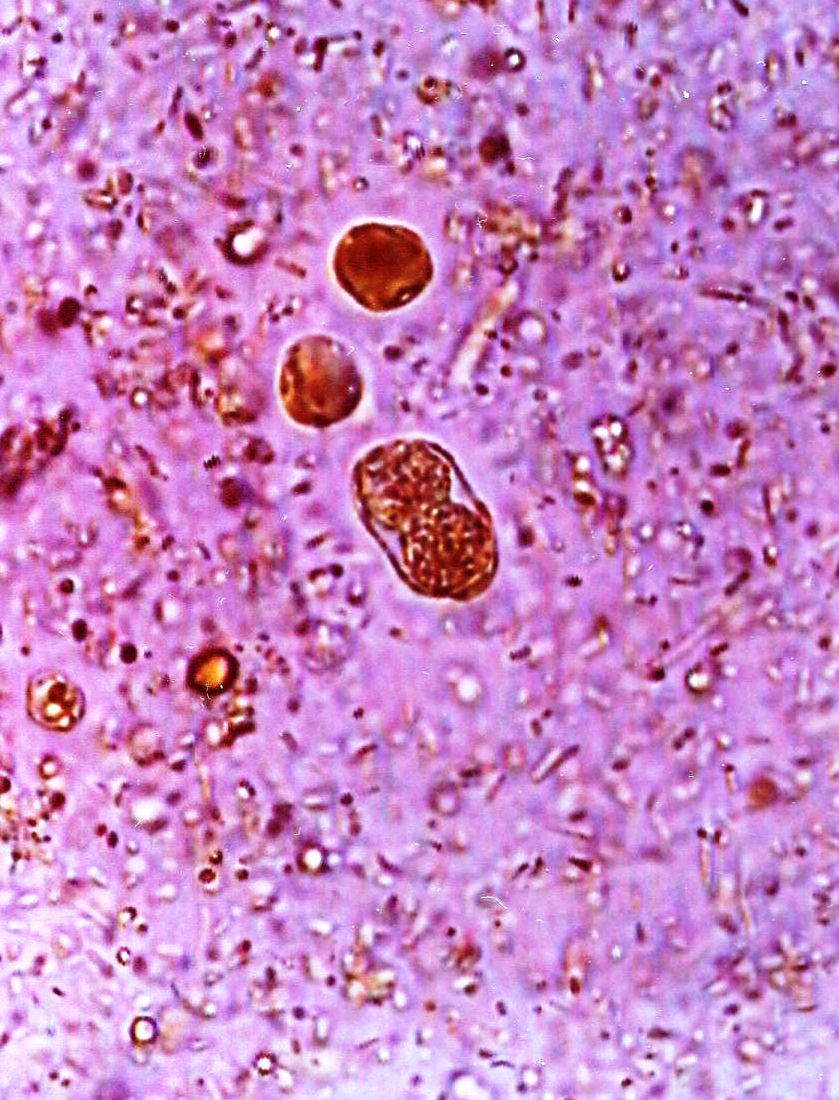 Blastocystis hominis dividing
Blastocystis hominis dividing
When Blastocystis is dividing intense pathology is expected as a dividing population indicated fast multiplication of the organsim and increasing population size.
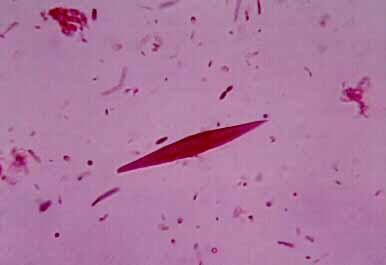 Charcot-Leyden crystals
Charcot-Leyden crystals
Charcot-Leyden crystals are by-products of the breakdown of certain human white blood cells as a result of their destruction by certain parasites such as Entamoeba histolytica . Their recovery in fecal samples thus indicates the presence of certain parasites.
1.jpg) Clonorchis sinensis (Chinese liver fluke)
Clonorchis sinensis (Chinese liver fluke)
Chinese liver flukes spend their immature stages as parasites of snails then fish before infecting a human being upon the ingestion of raw infected fish. The life span of the adult worm in the human host may reach 20-25 years.
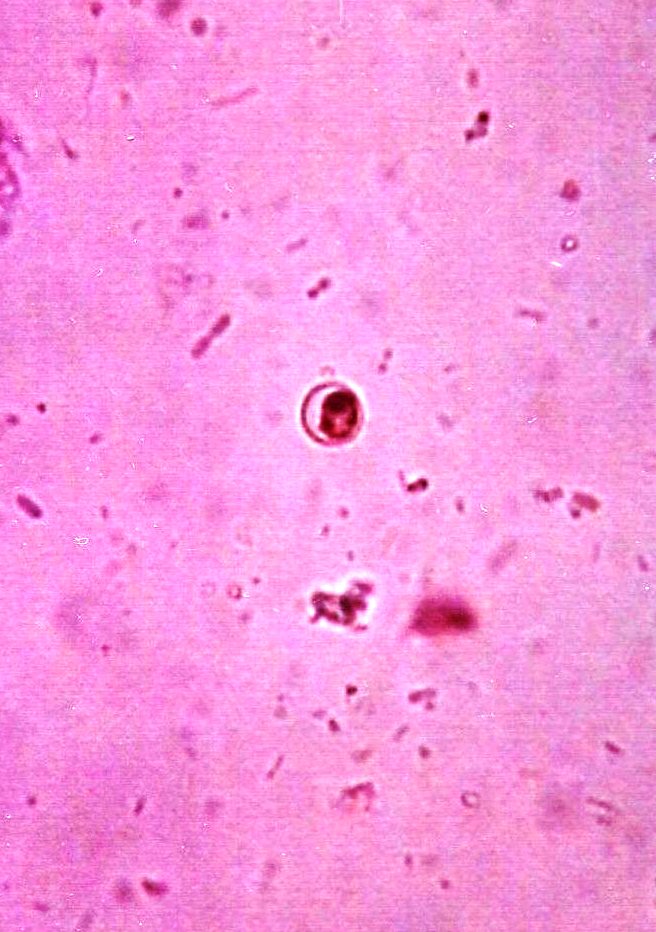 Cryptosporidum parvum
Cryptosporidum parvum
Cryptosporidium parvum is perhaps the most common new parasitic disease in the USA. Infection occurs from drinking water contaminated with calf fecal sources. The tap water of nearly 1/5 of all U.S. homes include infective stages of cryptosporidium as well as Giardia. Symptoms may be present in intestinal as well as extra-intestinal sites and may include fatigue and allergies.
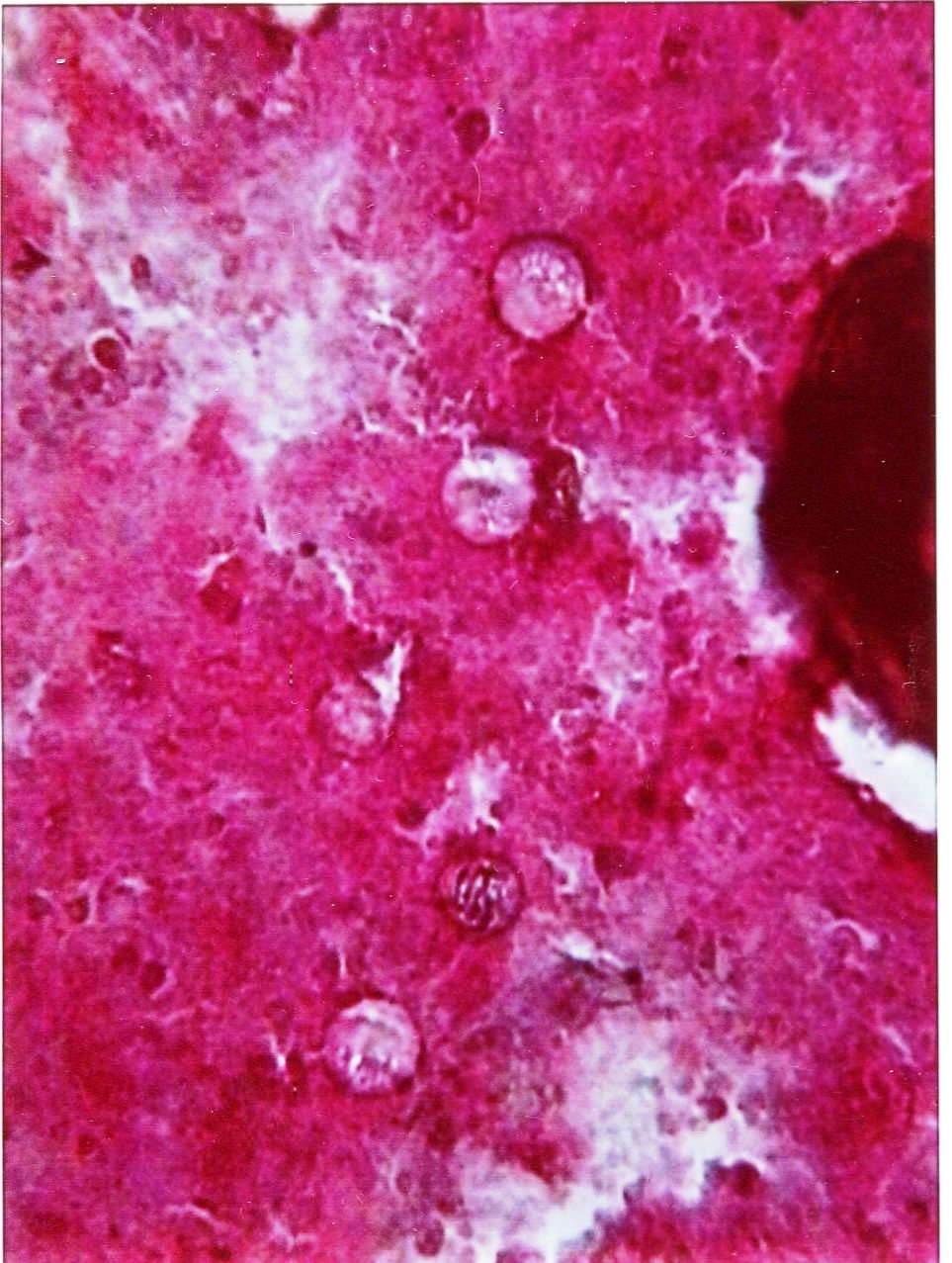 Cyclospora cayetanensis
Cyclospora cayetanensis
This parasite is similar to Crytposporium that is purported to be introduced to the United States with berries and other fruits from South America. However recent research shows that the parasite is freely transmitted in fresh vegetables in S. America as well as being waterborne in the U.S. cities served by surface water treatment plants.
 egg.jpg) Diphyllobothrium latum (tapeworm) egg
Diphyllobothrium latum (tapeworm) egg
The broad fish tapeworm which may reach up to ten feet coiled in the human intestine lays thousands of eggs liuke this one everyday during a lifespan of up to ten years.
.jpg) Entamoeba coli cyst
Entamoeba coli cyst
The cyst of E. coli is a transmission stage of infection from one patient to another. It is a non-feeding stage that resists adverse environmental condtipns outside the host. It is not as damaging as E. histolytica, however, it is known to cause severe diarrhea, especially in children.
.jpg) Entamoeba histolytica trophozoite
Entamoeba histolytica trophozoite
This is the feeding stage of the most serious protozoan parasite in the human intestine that sometimes penetrates the gut wall and ends up in the liver and any other part of the body that the blood reaches. Common symptoms include bloody diarrhea (Montezuma's Revenge), inflammation, dysfunction of the liver, and stroke.
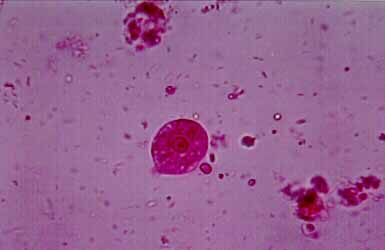 Entamoeba histolytica trophozoite
Entamoeba histolytica trophozoite
Entamoeba histolytica trophozoites cause intestinal pain, diarrhea / constipation (Montezuma's revenge), immune depression, and skin disorders. It may also cause liver, brain or other tissue pathology. It is transmitted through direct or indirect fecal-oral contamination.
 egg.jpg) Enterobius vermicularis (pinworm)
Enterobius vermicularis (pinworm)
These pinworm eggs are the diagnostic stages for serious infections that afflict mostly children and the elderly in the United States and elsewhere in the world.
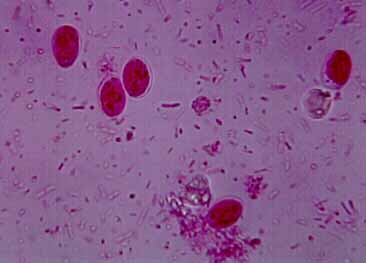 Giardia Lamblia
Giardia Lamblia
Giardia Lamblia cysts cause severe gastro-intestinal symptoms including diarrhea, abdominal cramps, and malabsorption of food and medication alike. Drinking infected stream water usually causes infection.
 egg.jpg) P westernmani (Human lung fluke)
P westernmani (Human lung fluke)
This human lung fluke produces eggs like this one that are eliminated with the host stool into water environment after which they spend their immature stages in intermediate hosts such as snails and crabs. When the crab is eaten, a new host becomes infected.
 larva.jpg) Strongyloides stercoralis (threadworm) larva
Strongyloides stercoralis (threadworm) larva
This threadworm, Strongyloides, is diagnosed in cases where infection is acquired by the penetration of the larva stages into the bare skin of people exposed to soiled environment contaminated with fecal matter from infected cases.
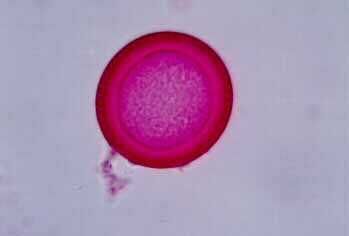 Taenia solium
Taenia solium
The recovery of eggs of the human/swine tapeworm Taenia solium indicates the presence of the ten-foot long adults in the intestine. When the immature cysts are present in other organ systems, they often invade the brain and sense organs causing neurocysticerocosis (damage to the central nervous system).
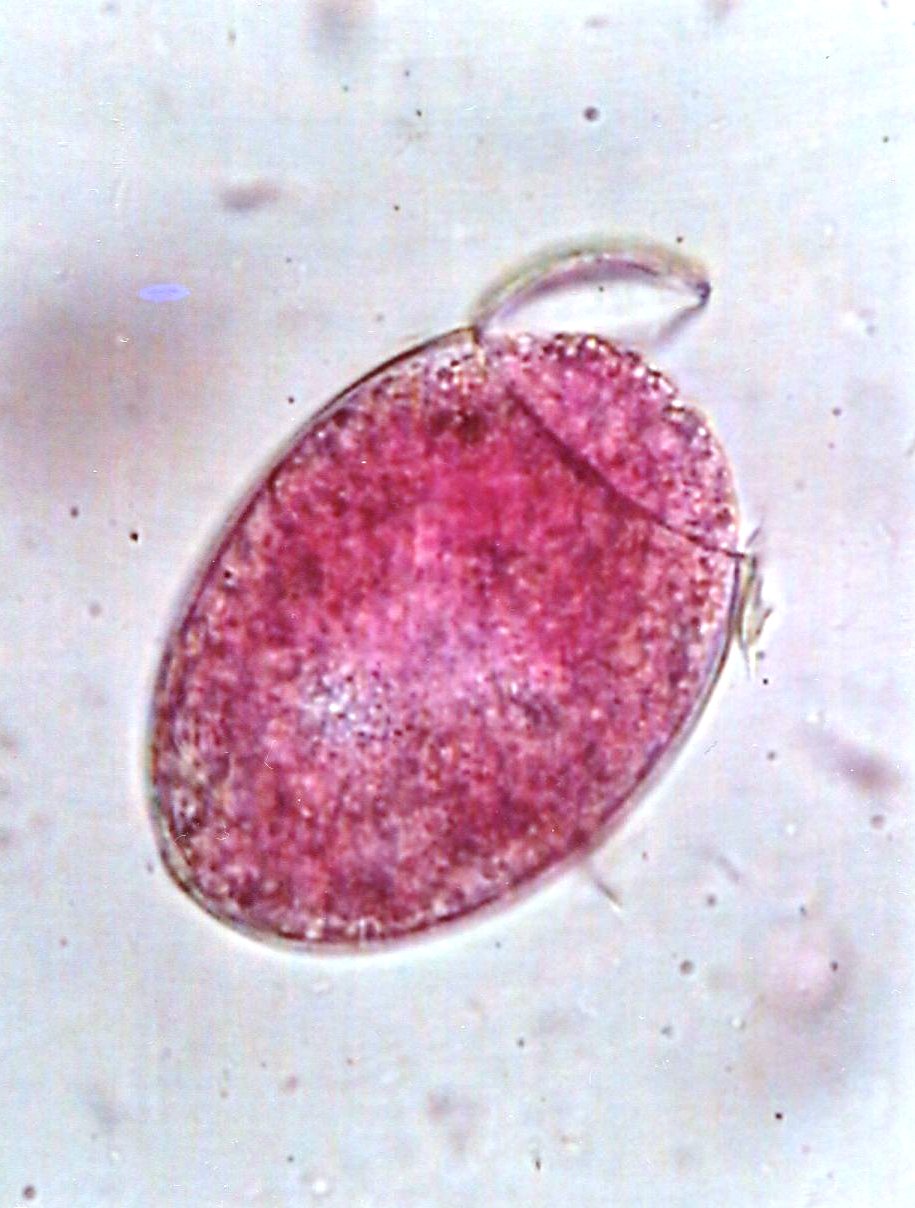 Tapeworm egg
Tapeworm egg
This broad fish tapeworm egg is one of many that are eliminated from infected hosts into the water where they are ingested by Copepod crustacean in which they develop before being ingested by fish which subsequently transmits the infection to humans.
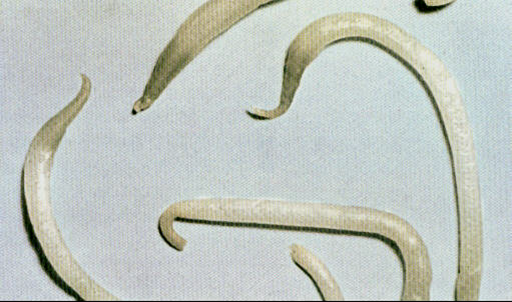 Bean Sprouts
Bean Sprouts
Bean sprouts are undigested plant parts that are indicators of diet preferences and can be confused with small roundworms.
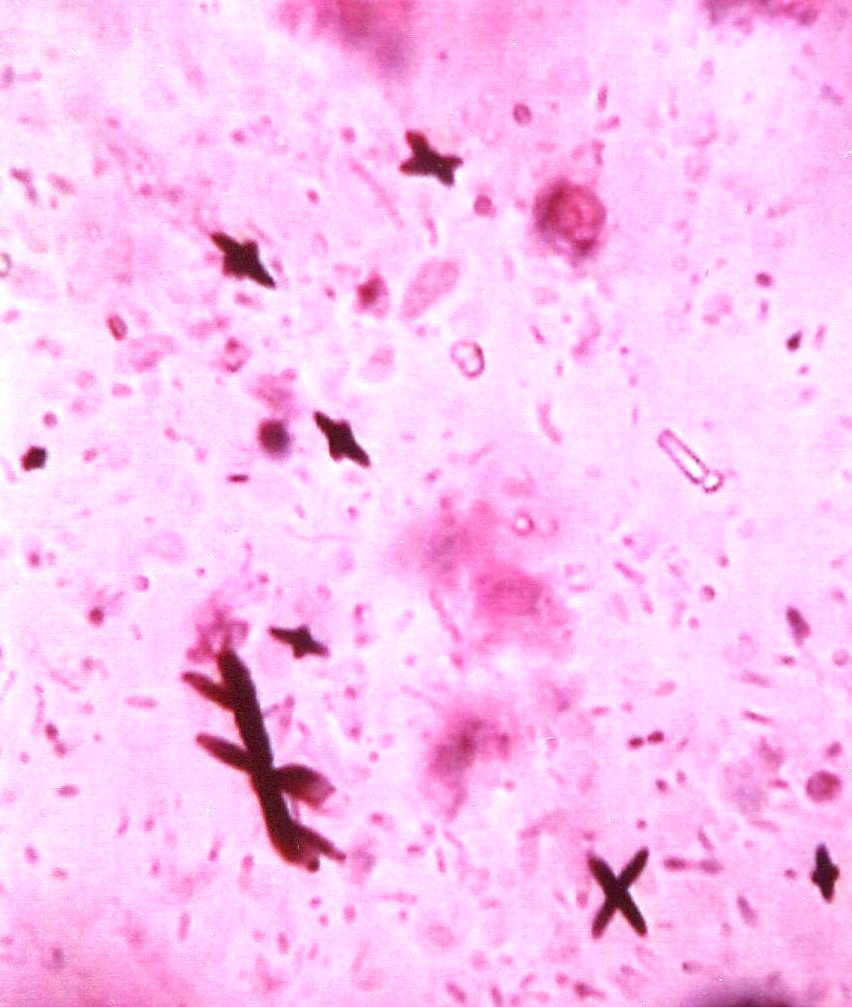 Crystals
Crystals
These crystals are present in patients who are heavily medicated with antibiotics.
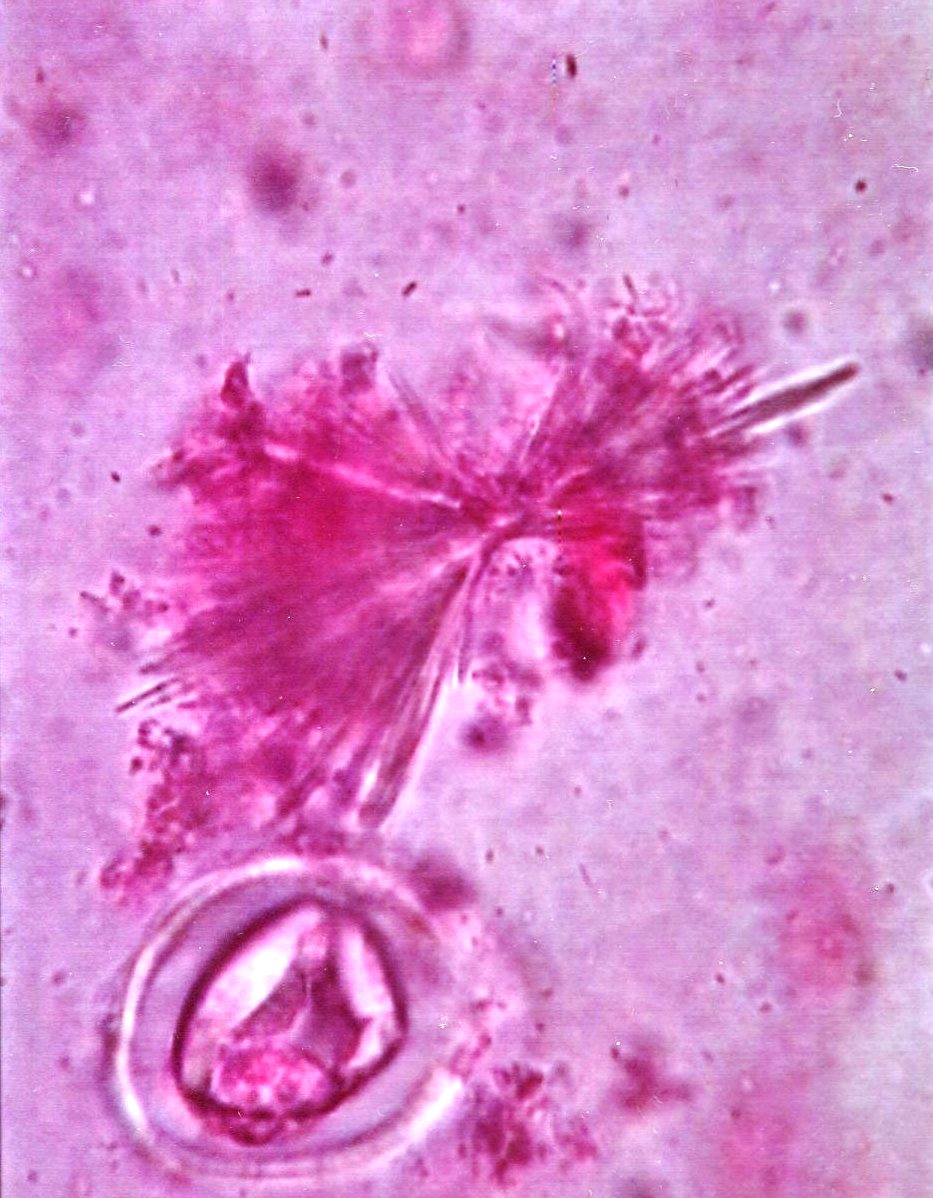 Fatty acid crystal
Fatty acid crystal
Fatty acid crystals are found when the fatty acids are not broken down by pancreatic lipases, This is usually seen in patients with gall bladder problems and pancreatic dysfunction.
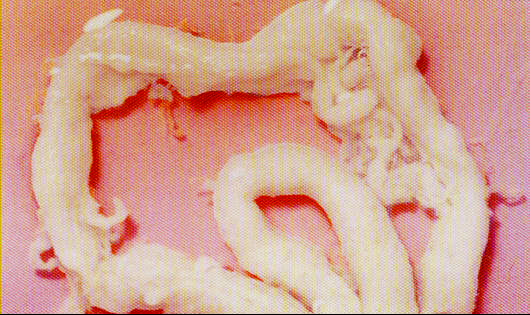 Mucoid tubes
Mucoid tubes
Mucoid tubes are a natural secretion of the intestinal lining that protects it from comprimisong factors such as parasites, toxins, infavorable PH levels, etc. They are often confused as roundworms.
.jpg) Normal bacilli (good bacteria)
Normal bacilli (good bacteria)
Normal bacilli are the rod shaped good bacteria that include the Bifidus and Lactobacillus forms and are important for balanced GI function.
.jpg) Blastoschizomyces (fungi)
Blastoschizomyces (fungi)
The image portrayed is that of a vegatative form as cultured in an artificial media to observe it's growth, infectivity, and resistance to chemical treatment.
.jpg) Candida albicans (in culture form)
Candida albicans (in culture form)
Candida albicans, the common cause of Candidiasis, can be cultured for experimental purposes, to ascertain it's identity.
.jpg) Candida in lungs
Candida in lungs
Intestinal Candidiasis can become bloodborne and turn systemic affecting a large variety of organ systems including the lungs.
.jpg) Cryptococcus laurentis (fungi)
Cryptococcus laurentis (fungi)
Cryptococcus is one of the many different kinds of fungi that can be found in fecal specimens of infected patients.
.jpg) Heavy Candida infection
Heavy Candida infection
Heavy Candida infections are commonly encountered with a change in the acidity Ph levels of the intestinal tract and are commonly associated with autism. Treatment of Candidaisis in autistic children usually involve the administration of caprylic acid which is usually deficient in autistic children.
.jpg) Heavy infection of common yeast
Heavy infection of common yeast
The common yeast is often found in human fecal specimens, especially men. It is a common fungus that can become pathogenic when found in high numbers or dividing.
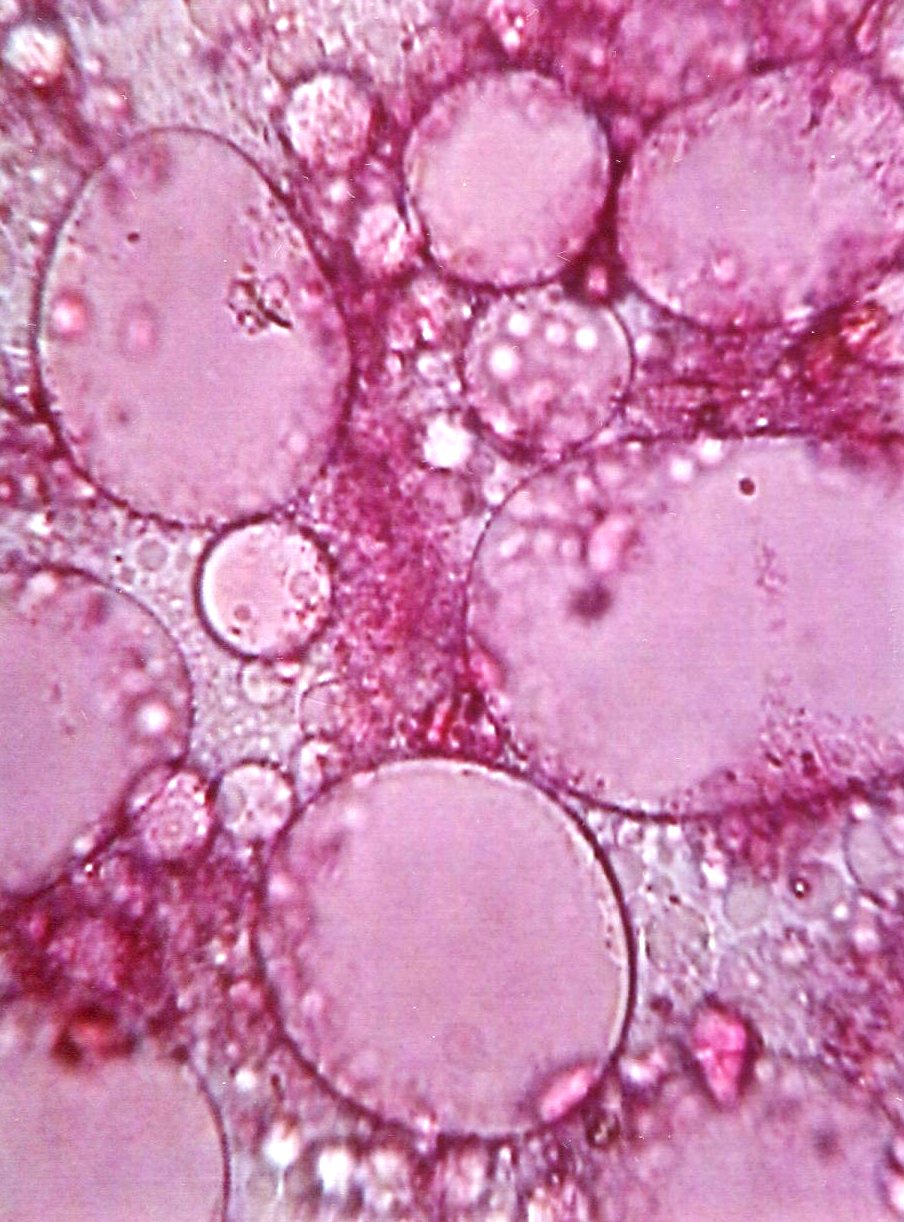 Heavy mucus
Heavy mucus
This heavy precense of mucus balls indicates serious intestinal pathology caused by a large number of Cryptosporiodum organisms.
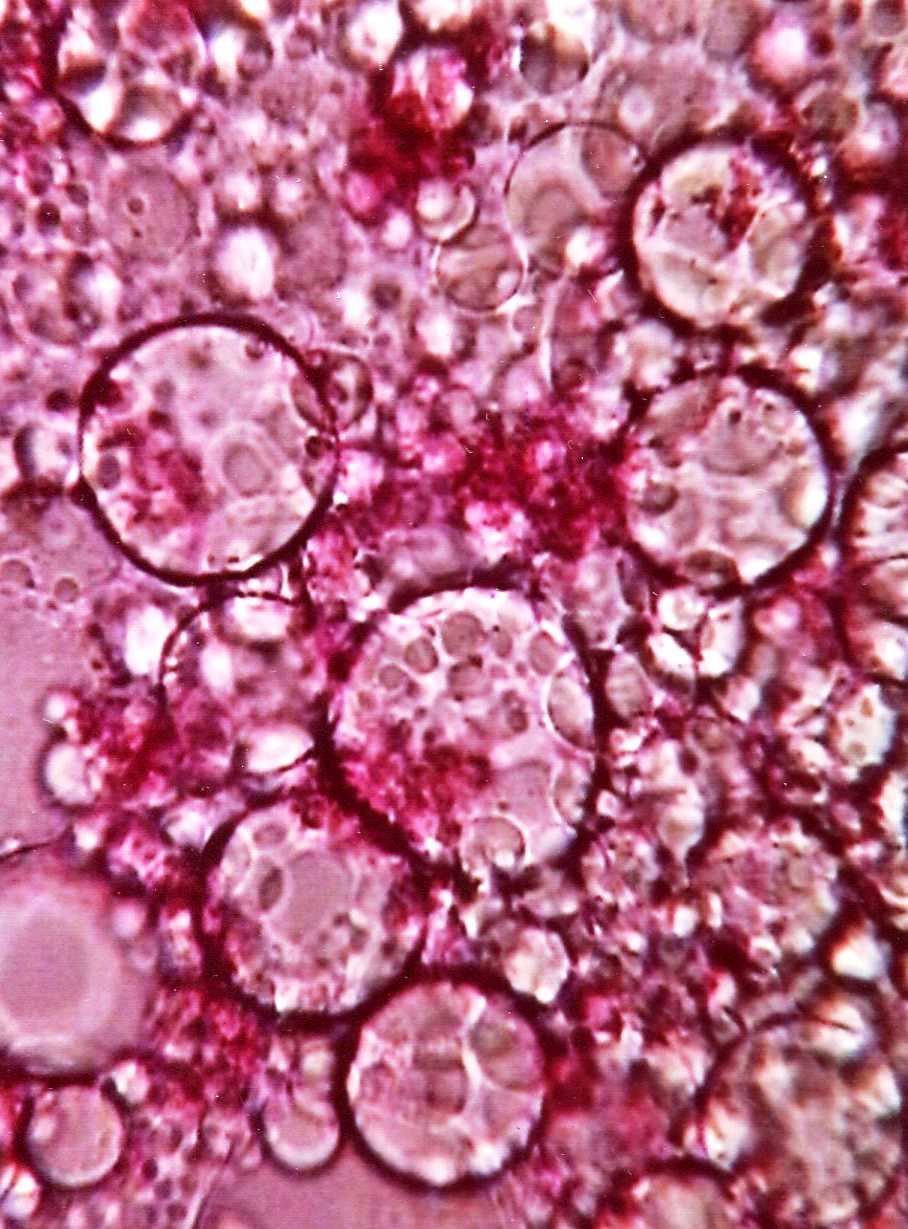 Very heavy mucus
Very heavy mucus
Heavy mucus secretions are usually observed when the intestinal lining is comprimised by a high intensity parasitic infection. In this particular case this mucus secretion was caused by Blastocystis hominis.


